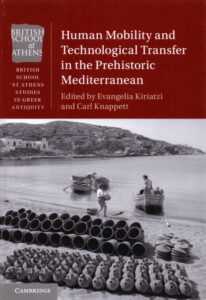ΑΡΘΡΑ | 2016
Late Pleistocene to Early Holocene Sea-Crossings in the Aegean: Direct, Indirect and Controversial Evidence
Στο M. Ghilardi, F. Leandri, J. Bloemendal, L. Lespez & S. Fachard (eds) 2016. Géoarchélogie des îles de Mediterranée, Paris: 33-46.
This paper reviews the geoarchaeological evidence for the early prehistoric sea-crossings in the Aegean (Eastern Mediterranean). It stresses the differences in character and scale between the initial serendipitous crossings and the fully-organised maritime networks of the later parts of prehistory.La diffusion du Néolithique en Méditerranée
Στο M. Ghilardi, F. Leandri, J. Bloemendal, L. Lespez & S. Fachard (eds) 2016. Géoarchélogie des îles de Mediterranée, Paris: 23-32.
Cet article propose une synthèse sur la chronologie et les caractères de la diffusion du Néolithique depuis le Proche-Orient jusqu’au Maroc à travers l’espace méditerranéen. Après avoir résumé les principales étapes de l’émergence de l’économie agricole dans la zone levantine, le cas de Chypre est plus particulièrement évoqué: les répercussions des avancées continentales y sont précoces, dès le Xe millénaire avant notre ère, tandis que l’île évoluera ensuite vers un conservatisme particulier (culture de Khirokitia).Examining the chaîne opératoire of the Late Cypriot II-IIIA Female Terracotta Figurines: Preliminary Results of the Experimental Approach
Στο R. Maguire & J. Chick (eds) 2016. Approaching Cyprus. Proceedings of the Post-Graduate Conference of Cypriot Archaeology (PoCA) held at the University of East Anglia, Norwich, 1st-3rd November 2013, Newcastle upon Tyne: 98-109.
Broadly speaking, the handmade female terracottas can be stylistically separated into two groups comprising both hollow and solid examples: the so called “bird-headed” (Type A) and “flat-headed” (Type B) figurines. While examining their chaîne opératoire, an experimental methodology was employed to draw out additional information relating to their manufacture.The Development of Protohistoric Jewellery from Cyprus and the Aegean: An Analysis with Special Reference to Signs of Cultural Interconnections
Στο R. Maguire & J. Chick (eds) 2016. Approaching Cyprus. Proceedings of the Post-Graduate Conference of Cypriot Archaeology (PoCA) held at the University of East Anglia, Norwich, 1st-3rd November 2013, Newcastle upon Tyne: 40-59.
The aim of the following analysis is an identification of changes and continuity in the style and composition of the jewellery which occurred in Cyprus and the Aegean during the Late Bronze Age and the (Early) Iron Age.Libations and the Use of Mycenaean Conical Rhyta in Ritual Practice in the Late Cypriot IIA-IIIA Periods
Στο R. Maguire & J. Chick (eds) 2016. Approaching Cyprus. Proceedings of the Post-Graduate Conference of Cypriot Archaeology (PoCA) held at the University of East Anglia, Norwich, 1st-3rd November 2013, Newcastle upon Tyne: 22-39.
The end of the Late Bronze Age in Cyprus is a time of multiple social and economic transformations. This period is often characterized by substantial culture contact due to developments in seafaring as well as intensification of the copper industry, significant trade with the Aegean, and a reworking of ritual spaces.A Linguistic Approach to Population Movement to Ancient Cyprus
Στο R. Maguire & J. Chick (eds) 2016. Approaching Cyprus. Proceedings of the Post-Graduate Conference of Cypriot Archaeology (PoCA) held at the University of East Anglia, Norwich, 1st-3rd November 2013, Newcastle upon Tyne): 2-21.
This chapter seeks to integrate the direct linguistic data with the archaeological, and suggests that a wholescale migration episode does not reflect the evidence well. Instead, it is argued that we should view the arrival of the Greek language on Cyprus as a long-term process during which speakers of other Cypriot languages chose to start speaking Greek, a hypothesis not incompatible with the “hybridisation” model of understanding social change on the island in this period.Scene di prothesis e di deposizione a Creta e sul continente greco in età micenea
Στο F. Longo, R. di Cesare & S. Privitera (eds) 2016. ΔΡΟΜΟΙ. Studi sul mondo antico offerti a Emanuele Greco dagli allievi della Scuola Archeologica Italiana di Atene, Atene-Paestum: 681-694.
This paper deals with depictions of two specific moments of the Late Bronze Age III funeral ritual that are poorly attested in Aegean art, both on Crete and on the mainland, namely, the exposure of the deceased (prothesis) and his or her subsequent deposition in the coffin.“Apparire” o “essere”? Questioni di status nella Creta palaziale
Στο F. Longo, R. di Cesare & S. Privitera (eds) 2016. ΔΡΟΜΟΙ. Studi sul mondo antico offerti a Emanuele Greco dagli allievi della Scuola Archeologica Italiana di Atene, Atene-Paestum: 669-680.
Earlier studies have showed that Minoan iconography placed special emphasis on the connection of attire and hairstyle with the age of individuals. The article argues that this emphasis was due to the key role that corporative groups structured on an age basis played in social life and the management of political power in palatial Crete.La ceramica in contesto. L’ edificio protopalaziale sull’ Acropoli Mediana di Festos nel MM IIB
Στο F. Longo, R. di Cesare & S. Privitera (eds) 2016. ΔΡΟΜΟΙ. Studi sul mondo antico offerti a Emanuele Greco dagli allievi della Scuola Archeologica Italiana di Atene, Atene-Paestum: 437-446.
The protopalatial building comprising rooms CV, CVI and CVII is located 100 m west of the Palace of Phaistos, on the southwestern slope of the so-called “Middle Acropolis’’. The complex, which was the object of a rescue excavation between 1969 and 1971, shows features setting it sharply apart from the other domestic structures unearthed outside the palace area. These features suggest it was a building with special functions.Mycenaean Greece and the Aegean World. Palace and Province in the Late Bronze Age
Cambridge

Οικιστική οργάνωση στην προϊστορική Ελλάδα. Η Νεολιθική και η Πρώιμη Εποχή του Χαλκού
Θεσσαλονίκη

Human Mobility and Technological Transfer in the Prehistoric Mediterranean
Cambridge

Manuale di epigrafia micenea. Introduzione allo studio dei testi in lineare B
Padova

